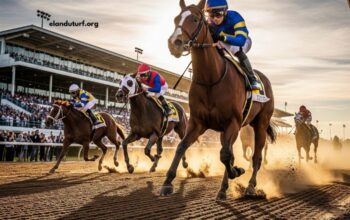In the world of horse racing, every bettor dreams of hitting the jackpot with the right prediction. However, the reality is far more complex. The Les Craks Du Turf strategy is widely recognized by experts in the field as an approach to consistently placing profitable bets on horse races. It involves not just luck but a deep understanding of the horses, jockeys, race conditions, and most importantly, a thorough analysis of historical data and current form.
With so many variables at play, it’s easy to see why only a select few bettors have mastered the art of making accurate predictions. The Les Craks Du Turf approach takes into account a range of factors that influence a race’s outcome, and it requires a disciplined, data-driven mindset to be successful. In this article, we will explore the key elements that define the Les Craks Du Turf system and how both novice and experienced bettors can leverage it to their advantage.
What exactly is the Les Craks Du Turf strategy?
The Les Craks Du Turf strategy is a comprehensive and data-driven approach to betting on horse races. “Les Craks” is a term often used in the French horse racing community to refer to top-tier performers—those who consistently excel on the track. In this context, the term is applied to bettors who have mastered the art of analyzing races and making profitable predictions. The Les Craks Du Turf strategy involves a combination of understanding race conditions, horse form, trainer statistics, and jockey performance.
A key part of the Les Craks Du Turf methodology is identifying value bets—those that might not be obvious to the casual bettor but offer good returns based on careful analysis. This is achieved by studying a range of factors, including the past performance of horses in similar conditions, the skill set of jockeys, and how horses perform on different types of tracks. In essence, the Les Craks Du Turf strategy transforms betting from a game of luck to a science of prediction, relying on data and analysis to guide decision-making.
Success with the Les Craks Du Turf approach doesn’t come overnight. It requires persistence, patience, and the ability to evaluate data objectively. The bettors who follow this strategy don’t rely on gut feelings or random hunches but instead employ a disciplined approach that takes into account every available piece of information. Through consistent application of this method, Les Craks Du Turf bettors are able to increase their chances of winning and reduce the risks involved in horse racing betting.
How do Les Craks Du Turf analyze horse form?
Understanding a horse’s form is one of the cornerstones of the Les Craks Du Turf strategy. A horse’s form is essentially a reflection of its past performance, and it provides valuable insights into how a horse is likely to perform in future races. Bettors who follow the Les Craks Du Turf method place a strong emphasis on studying these form guides, which detail a horse’s performance over a specific period.
When analyzing horse form, Les Craks Du Turf bettors look for trends—whether a horse is improving, maintaining consistent performance, or showing signs of decline. For example, a horse that has finished in the top three in several races in a particular type of race or track condition is likely to be a strong contender in future events. Additionally, bettors analyze the times in which a horse finishes a race, as well as the competition faced, to gauge the true quality of its form.
Another important aspect of form analysis in the Les Craks Du Turf strategy is the evaluation of the horse’s performance in relation to the specific conditions of the race. A horse may perform well on certain types of tracks but struggle on others. For example, a horse that excels on soft turf may not perform as well on a firm track. By considering how a horse’s form aligns with the conditions of the race, Les Craks Du Turf bettors can identify horses with the best potential to succeed.
What role do jockeys play in the Les Craks Du Turf strategy?
The role of the jockey is often underestimated by casual bettors, but in the Les Craks Du Turf system, jockey performance is a key factor in predicting the outcome of a race. The jockey’s skill, experience, and familiarity with the horse can make a significant difference in a race. A good jockey knows how to manage a horse’s energy, when to push for a faster pace, and when to hold back, making them integral to a horse’s chances of success.
In the Les Craks Du Turf strategy, bettors study the performance of individual jockeys and their track record with certain horses. If a jockey has consistently led a particular horse to victory in past races, their partnership is likely to be a good indicator of success. Les Craks Du Turf bettors often keep an eye on which jockeys are riding which horses and how well they have performed in similar conditions or race types. This information is crucial for making informed predictions.
Additionally, the Les Craks Du Turf strategy emphasizes the importance of understanding how jockeys perform under various conditions. Some jockeys excel in high-pressure situations, while others may struggle when faced with difficult weather conditions or a competitive field. By closely monitoring jockey statistics and performance, bettors can gain an edge in identifying which horses are most likely to win based on their rider’s expertise.
How do Les Craks Du Turf assess race conditions?
Race conditions play a vital role in the Les Craks Du Turf strategy. The type of track, the weather, and the time of day can all influence the outcome of a race. Experienced bettors who follow the Les Craks Du Turf methodology understand that these external factors should never be overlooked. Whether the track is firm, soft, or heavy, each condition can dramatically affect how a horse performs.
For example, a horse that performs well on a soft, muddy track may struggle on a dry, firm track. Similarly, some horses thrive in cooler conditions, while others are better suited for warm weather. The Les Craks Du Turf strategy involves closely studying race conditions and matching them with horses that have demonstrated strong performances in similar situations. This allows bettors to make more informed predictions about which horses are most likely to succeed.
In addition to track conditions, the time of day can also influence a race’s outcome. Some horses are known to perform better in the morning, while others show their best form in the afternoon or evening. By paying attention to these nuances, Les Craks Du Turf bettors can better anticipate how horses will perform under specific race conditions.
How do Les Craks Du Turf use statistical analysis to improve their bets?
Statistical analysis is another crucial element of the Les Craks Du Turf approach. This involves studying past performances, comparing different horses’ statistics, and identifying trends that may indicate a higher probability of success. For example, bettors may look at statistics such as win percentages, average race times, and consistency across different race types and conditions. These numbers provide valuable insights into which horses are most likely to perform well in a given race.
The Les Craks Du Turf strategy encourages bettors to use data to find patterns that can give them a competitive edge. By analyzing a horse’s performance in relation to various factors such as track condition, race length, and competition, bettors can develop a more accurate picture of which horses are most likely to win. This helps to identify value bets—those horses that offer good returns relative to the risk involved.
Moreover, Les Craks Du Turf bettors often look for statistical anomalies, such as a horse that is undervalued by the betting market based on its past performance. These opportunities present themselves when a horse’s odds do not align with its actual chances of winning. Through careful analysis, Les Craks Du Turf bettors can take advantage of these discrepancies to place profitable bets.
How do Les Craks Du Turf bettors manage their bankroll?
Bankroll management is a fundamental aspect of the Les Craks Du Turf strategy. Successful bettors know that it’s not just about placing as many bets as possible, but rather making calculated wagers that are within their budget. The Les Craks Du Turf approach encourages bettors to set clear limits on how much they are willing to risk in a given period, ensuring that they can continue to bet responsibly even after experiencing a losing streak.
One key principle of bankroll management is avoiding large bets on high-risk races. Instead, Les Craks Du Turf bettors typically place smaller bets on races that they have thoroughly analyzed and where they believe they have an edge. This helps mitigate the risks involved in betting and ensures that losses are kept to a minimum. By practicing discipline in bankroll management, bettors can sustain their betting activity over the long term and increase their chances of profitable returns.
Another important element is tracking all bets and analyzing which strategies are working. By doing so, Les Craks Du Turf bettors can refine their methods, learn from past mistakes, and adjust their approach as necessary to maximize long-term profitability.
Conclusion
The Les Craks Du Turf strategy is a comprehensive approach to horse racing betting that combines in-depth analysis, careful planning, and a disciplined mindset. By understanding horse form, race conditions, jockey performance, and statistical data, bettors can make more informed predictions and reduce the inherent risks of betting. This method requires dedication, persistence, and a commitment to continuous learning, but for those who are willing to put in the work, the Les Craks Du Turf strategy offers a powerful way to increase the chances of consistent success in horse racing betting. Through this approach, bettors can transform their hobby into a more calculated and profitable endeavor, maximizing their potential in the competitive world of horse racing.







